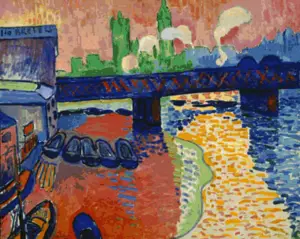Fauvism
Les Fauves (French for The Wild Beasts) were a short-lived and loose grouping of early 20th century Modern artists whose works emphasized painterly qualities, and the imaginative use of deep color over the representational values retained by Impressionism. Fauvists simplified lines, made the subject of the painting easy to read, exaggerated perspectives and an interesting prescient prediction of the Fauves was expressed in 1888 by Paul Gauguin to Paul Sérusier,
"How do you see these trees? They are yellow. So, put in yellow; this shadow, rather blue, paint it with pure ultramarine; these red leaves? Put in vermilion."
Les Fauves
The name was given, humourously and not as a compliment, to the group by art critic Louis Vauxcelles. The French word, "Fauves" means "wild beasts." Gustave Moreau was the movement's inspirational teacher; a professor at the École des Beaux-Arts in Paris, and a Symbolist painter he pushed his students to think outside of the lines of formality and to follow their visions.
The leaders of the movement, Moreau's top students, were Henri Matisse and André Derain — friendly rivals of a sort, each with his own followers. The paintings, for example Matisse's 1909 La Danse or Derain's The Two Barges,[1] use powerful blues, oranges, reds or other forceful colors to draw the eye. Matisse became the yang to Picasso's yin in the 20th century while time has trapped Derain at the century's beginning, a "wild beast" forever. Their disciples included Albert Marquet, Charles Camoin, the Belgian painter Henri Evenepoel, Jean Puy, Maurice de Vlaminck, Raoul Dufy, Othon Friesz, Georges Rouault, the Dutch painter Kees van Dongen, the Swiss painter Alice Bailly and Picasso's partner in Cubism, Georges Braque.
Fauvism, as a movement, had no concrete theories, and was short lived, beginning in 1905 and ending in 1907, they only had three exhibitions. Matisse was seen as the leader of the movement, due to his seniority in age and prior self-establishment in the academic art world. He said he wanted to create art to delight; art as a decoration was his purpose and it can be said that his use of bright colors tries to maintain serenity of composition.
Among the influences of the movement were Paul Gauguin and Vincent van Gogh, both of whom had begun using colors in a brighter, more imaginative manner. The pointillism of Georges Seurat, and in particular Paul Signac, and the other Neo-impressionist painters and the work of Paul Cezanne were also central.
The French painter Emile Bellet cites Fauvism as an influence.
Fauve paintings
ReferencesISBN links support NWE through referral fees
- Rewald, John. The John Hay Whitney Collection, National Gallery of Art, Washington. ISBN 0894680668
- Tansey, Richard G. and Fred S. Kleiner,Gardner's Art Through the Ages Harcourt Brace, 1996. ISBN 0155011413
Further reading
- William H. Gerdts (1995). The Color of Modernism: The American Fauves. New York: Hollis Taggart Galleries.
- Sarah Whitfield (1991). Fauvism. London: Thames And Hudson.
External links
- Fauve Painting from the Permanent Collection at the National Gallery of Art
- Fauvism: The Wild Beasts of Early Twentieth Century Art
- Fauvism
| Western art movements |
| Renaissance · Mannerism · Baroque · Rococo · Neoclassicism · Romanticism · Realism · Pre-Raphaelite · Academic · Impressionism · Post-Impressionism |
| 20th century |
| Modernism · Cubism · Expressionism · Abstract expressionism · Abstract · Neue Künstlervereinigung München · Der Blaue Reiter · Die Brücke · Dada · Fauvism · Art Nouveau · Bauhaus · De Stijl · Art Deco · Pop art · Futurism · Suprematism · Surrealism · Minimalism · Post-Modernism · Conceptual art |
| Modernism | |
|---|---|
| 20th century - Modernity - Existentialism | |
| Modernism (music): 20th century classical music - Atonality - Serialism - Jazz | |
| Modernist literature - Modernist poetry | |
| Modern art - Symbolism (arts) - Impressionism - Expressionism - Cubism - Surrealism - Dadaism - Futurism (art) - Fauvism - Pop Art - Minimalism | |
| Modern dance - Expressionist dance | |
| Modern architecture - Brutalism - De Stijl - Functionalism - Futurism - Heliopolis style - International Style - Organicism - Visionary architecture | |
| ...Preceded by Romanticism | Followed by Post-modernism... |
Credits
New World Encyclopedia writers and editors rewrote and completed the Wikipedia article in accordance with New World Encyclopedia standards. This article abides by terms of the Creative Commons CC-by-sa 3.0 License (CC-by-sa), which may be used and disseminated with proper attribution. Credit is due under the terms of this license that can reference both the New World Encyclopedia contributors and the selfless volunteer contributors of the Wikimedia Foundation. To cite this article click here for a list of acceptable citing formats.The history of earlier contributions by wikipedians is accessible to researchers here:
The history of this article since it was imported to New World Encyclopedia:
Note: Some restrictions may apply to use of individual images which are separately licensed.

